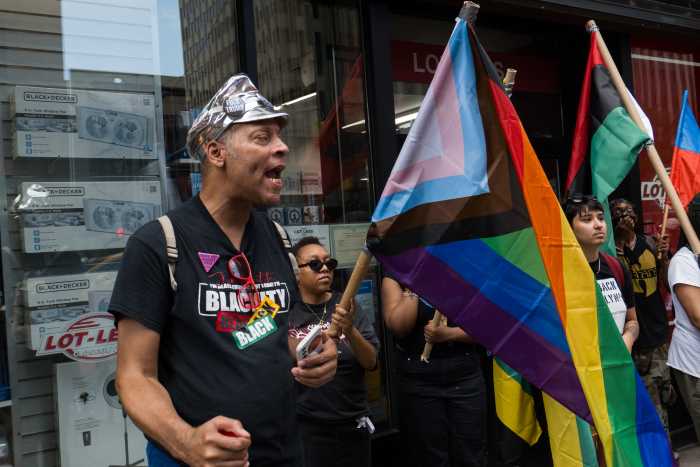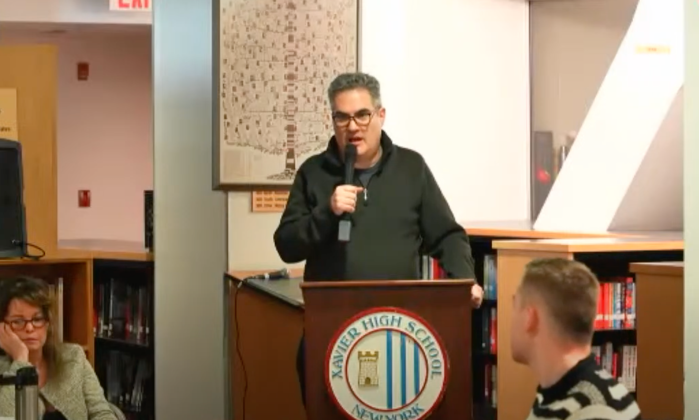On a recent day last month a cyclist cruised northward past 11th St. along a major Downtown avenue. His pace was leisurely, his manner relaxed. He did not swerve to avoid any jutting car doors or constantly jerk his head back to look out for taxis.
He didn’t have to. He was riding on Eighth Ave.’s new “cycle track” protected bike lane, and a buffer zone of parked cars stood between him and the afternoon traffic.
Across the sidewalk, however, Vincent Kim peered out at the lane from behind the counter of Imperial Vinters, a wine and liquor store on 11th St.
“I don’t like it,” Kim said, shrugging. “It’s good for bikers, but you lose parking, and deliveries are hard. The delivery truck has been ticketed for unloading in the lane.”
The fine was $115, paid by the delivery company.
Over the last two years Eighth and Ninth Aves. have received protected bike lanes, a design previously untested in American cities, which provides a dedicated lane for cyclists that is separated from traffic by parked cars. The design also uses a slew of innovations, such as sidewalk-island “pedestrian refuges,” left-turn lanes and bike-specific traffic signals to defuse intersection conflicts. With their novel lanes, Eighth and Ninth Aves. are acting as petri dishes in the city’s experiment to make bicycles a mainstay of the urban commute while chipping away at the dominance of cars.
“The lanes set a new standard for physical separateness,” said Wiley Norvell, a spokesperson for Transportation Alternatives, a bikers’ advocacy group that championed the design.
But as cyclists rejoice over the new lanes, merchants like Kim whose shops line the bike path are less enthused.
“It’s not a boon to business,” said James Waits, owner of House of Cards and Curiosities on Eighth Ave. at 12th St.
Tony Juliano, director of the Greenwich Village-Chelsea Chamber of Commerce, said that both he and the merchants he represents “completely understand the need to reduce vehicular traffic,” but remain concerned about the potential adverse effects on business.
He noted that when the Ninth Ave. lane opened, some merchants reported 20- to 30-percent drops in business. Juliano said no such reports had come in from Eighth Ave., but that other features could still hinder businesses.
On the other hand, bike enthusiasts argue that the lanes should increase business for adjacent shops.
One cyclist, Rashad, who paused for a few minutes to talk as he cycled the Eighth Ave. lane, said that it should bring new business to shopkeepers.
“Whatever falls on the lane — I go to those stores,” he said.
None of the merchants interviewed for this article said that they would directly link any decline in business to the bike path, though some said it was difficult to untangle the impact of the bike lane from the general economic downturn.
Or, as Waits put it: “It’s sort of like standing on the deck of a boat during a storm and wondering if you’ve wet your pants.”
Other problems are easier to discern. The design has cost the west side of Eighth Ave. quite a few parking spaces due to the left-turn lanes and pedestrian refuges, and, of course, delivery trucks must contend with a lack of loading space and an increase of tickets for standing.
One shop, though, seems perfectly suited to the new lane. Organic Avenue, a naturalist-lifestyle store between Jane and Horatio Sts. that distributes vegan raw food and organic clothing, uses a bike service to deliver its products, thereby integrating its organic approach into transportation and, incidentally, introducing a new use for the bike lane.
Alexandra Chavez, a clerk at Organic Avenue, added that the bike lane offers a new way for customers to reach the store.
“People get off their bikes and come in,” she said.
But, at least for now, Organic Avenue remains an exception to the standard business model, and Juliano of G.V.C.C.C. said that he wishes the Department of Transportation were more amenable to the needs of the business community. He said he was happy that businesses were alerted and consulted regarding the Eighth Ave. lane, but remained disappointed by the large “footprint” of the lane.
“I wish the D.O.T. could examine alternatives that aren’t as wide,” he said, referring to the generous 10 feet allotted to the bike lane. “It changes the character of the street.”
When told of this complaint, Norvell of Transportation Alternatives conceded that the lanes were rather wide, but said that the width was mandated by the Department of Sanitation, which needs enough space to send a street sweeper down the lane.
“Other cities have small street sweepers,” he said. “New York doesn’t.”
Norvell explained that the Eighth Ave. and Ninth Ave. lanes were purposely overbuilt in the same way the Brooklyn Bridge was overbuilt to err on the side of caution.
“These lanes are the first of their kind, and they were over-designed to be extra safe,” he said. “There’s a learning curve with streets like this. It takes a few years for people to use this in a confident and predictable way.”


































